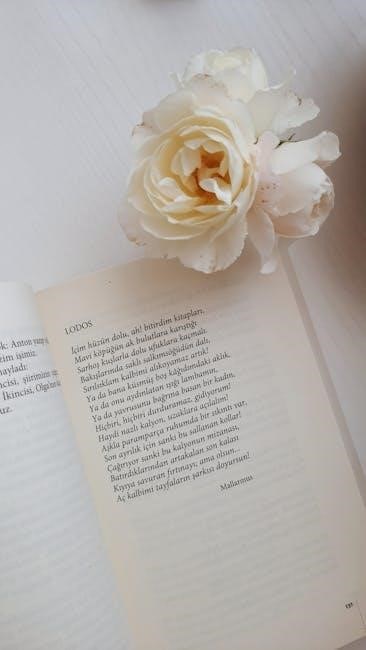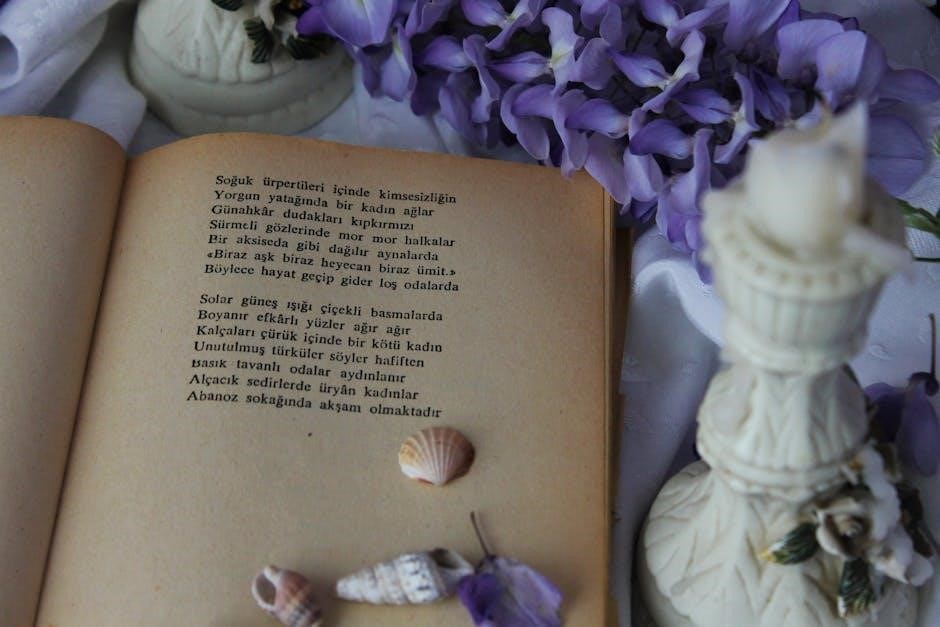to his coy mistress poem pdf

to his coy mistress poem pdf
Andrew Marvell’s 1681 poem, To His Coy Mistress, explores themes of love, time, and mortality with wit and irony, offering a profound reflection on life’s fleeting nature․ A PDF version is available for easy reading and analysis․

1․1 Overview of the Poem
“To His Coy Mistress” is a celebrated metaphysical poem by Andrew Marvell, known for its intricate argument and rich imagery․ The poem presents a persuasive appeal to the speaker’s reluctant lover, urging her to embrace the present and surrender to passion․ Through a structured, logical progression, Marvell explores themes of love, time, and mortality, blending humor with philosophical depth․ The poem is divided into three sections, each addressing a different aspect of the speaker’s plea․ Its wit, irony, and seductive language have made it a landmark in English literature, resonating with readers for centuries․
1․2 Historical Context and Background
“To His Coy Mistress” was written by Andrew Marvell in the 17th century, a period marked by significant social and political change in England․ The poem reflects the intellectual and literary trends of the time, blending metaphysical poetry’s complexity with a Carpe Diem theme․ Composed during the English Civil War and Restoration era, it captures the tension between Renaissance ideals of love and the emerging realism of the 17th century․ Marvell’s political and philosophical perspectives, as well as his wit, are woven into the poem, making it a product of its historical context while maintaining timeless appeal․

Structure and Composition of the Poem
The poem is divided into three sections, each addressing different aspects of the speaker’s argument․ It follows a structured rhyme scheme and meter, enhancing its musicality and emotional impact․
2․1 The Three Sections of the Poem
The poem is structured into three distinct sections, each serving a unique purpose in the speaker’s argument․ The first section expresses admiration for the mistress’s beauty, imagining a timeless, idealized love․ The second section contrasts this fantasy with the harsh reality of time’s passage and mortality․ The final section urges immediate action, advocating for seizing the moment․ This tripartite structure effectively builds tension and progression, guiding the reader through the speaker’s evolving emotions and persuasive strategy, creating a cohesive narrative flow that underscores the poem’s central themes of love, time, and urgency․
2․2 Rhyme Scheme and Meter
The poem follows a consistent rhyme scheme of AABB throughout its 46 lines, with each couplet contributing to the overall rhythm․ The meter is primarily iambic tetrameter, with four beats per line, creating a steady and deliberate pace․ This structure complements the speaker’s deliberate and persuasive tone, allowing for a natural flow of ideas․ The use of tetrameter adds a sense of urgency, mirroring the poem’s themes of time and immediacy․ The rhyme scheme enhances the musicality, making the poem both pleasing to read and effective in conveying its emotional depth and complexity․

Major Themes Explored in the Poem
The poem delves into themes of love, time, and mortality, urging the mistress to embrace the present and reject hesitation, highlighting life’s fleeting nature․
3․1 The Conflict Between Love and Time
The poem explores the tension between love’s idealized timeless nature and the relentless passage of time․ The speaker argues that while love could flourish in an eternal world, reality demands urgency․ Time, personified as a thief, steals youth and beauty, making delay in expressing love both impractical and tragic․ This conflict drives the speaker’s plea for immediate affection, emphasizing that procrastination risks losing the opportunity for connection․ The interplay between love’s enduring ideal and time’s harsh limitations underscores the poem’s central urging to seize the moment, blending romance with existential urgency․
3․2 The Carpe Diem Motif
The poem embodies the Carpe Diem motif, urging the coy mistress to embrace the present and seize fleeting opportunities for love․ The speaker argues that time is short, and delaying affection risks losing it entirely․ Through vivid imagery, such as the “youthful hue” and “passing time,” Marvell emphasizes the transience of life and beauty․ This motif is central to the poem’s persuasive structure, compelling the mistress to act swiftly rather than cling to hesitation․ The Carpe Diem theme not only reflects the urgency of love but also underscores the inevitability of loss, making immediate passion a moral and emotional imperative․
3․3 The Theme of Mortality and Transience
Mortality and transience are central themes in “To His Coy Mistress,” as Marvell reflects on the inevitability of death and the fleeting nature of beauty․ The poem contrasts the timeless adoration of the mistress with the harsh reality of aging and decay․ Imagery like “worms shall try that long-preserved virginity” underscores the irreversible passage of time․ This solemn awareness of mortality heightens the urgency of the speaker’s plea, emphasizing that life’s brief span demands immediate action․ The poem thus juxtaposes the eternal ideals of love with the finite human experience, creating a poignant meditation on life’s impermanence․

The Tone and Style of the Poem
The tone and style of “To His Coy Mistress” are complex, blending admiration with urgency․ The poem’s sophisticated language uses wit, irony, and rich imagery to convey seductive persuasion and emotional progression from reverence to passionate appeal․

4․1 Wit and Irony in the Poem
The poem showcases Marvell’s mastery of wit and irony, blending clever wordplay with subtle sarcasm․ The speaker humorously exaggerates the mistress’s beauty, comparing her to “vegetable love” that grows slowly, while paradoxically urging swift action․ Irony emerges in the contrast between the idealized flattery and the underlying pressure to surrender to time․ Marvell’s wit engages the reader, masking the poem’s deeper philosophical themes with charming, intellectual banter․ This duality of tone highlights the speaker’s cunning persuasion, making the poem both entertaining and thought-provoking․
4․2 The Use of Seductive Language
Marvell employs seductive language to charm and persuade, blending flattery with urgency․ He compliments the mistress’s beauty, comparing it to treasures like “two hundred years” of worship․ The poem’s intimate tone and vivid imagery, such as “vegetable love” and “youthful hue,” create a sense of allure․ Marvell’s words are both tender and passionate, appealing to the mistress’s emotions while emphasizing the fleeting nature of beauty․ This persuasive language Masks the poem’s deeper philosophical themes, making it a masterful blend of seduction and intellectual depth that captivates readers with its elegance and urgency․
4;3 The Emotional Progression of the Speaker
The speaker’s emotions evolve from admiration to urgency, reflecting the poem’s thematic depth․ Initially, he idealizes the mistress, expressing awe for her beauty and virtue․ This admiration transitions into a solemn reflection on mortality, as he acknowledges the inevitability of time’s passage․ Finally, his tone shifts to passionate persuasion, urging her to seize the moment․ This emotional journey from reverence to immediacy underscores the poem’s carpe diem message, revealing the speaker’s complex mix of desire, philosophy, and vulnerability․ His progression captivates readers, making the poem a compelling exploration of love and time․
Analysis of Key Imagery and Metaphors
The poem’s vivid imagery, such as “vegetable love” and time as a thief, reinforces themes of love, mortality, and urgency, creating a rich, layered exploration․
5․1 The “Vegetable Love” Metaphor
In the poem, Andrew Marvell uses the metaphor of “vegetable love” to describe a slow-growing, natural affection, contrasting it with the urgency of desire․ This metaphor, found in the first section, suggests that if time allowed, love could develop patiently, like a vegetable ripening on the vine․ However, the speaker argues that such leisure is impossible, emphasizing the need to seize the moment․ The imagery highlights the tension between idealized, gradual love and the harsh reality of fleeting opportunities, underscoring the poem’s carpe diem theme․
5․2 The Image of Time as a Thief
In “To His Coy Mistress,” Andrew Marvell portrays time as a thief that steals youth, beauty, and opportunities․ This imagery underscores the urgency of the speaker’s plea to his mistress․ Time is depicted as relentless, robbing individuals of their prime and leaving decay in its wake․ The metaphor emphasizes the fleeting nature of life and the necessity to act swiftly, aligning with the carpe diem theme․ By framing time as a thief, Marvell heightens the stakes, urging the mistress to embrace the present rather than risk losing her chance for love and passion․
5․3 The Contrasting Imagery of Youth and Decay
Andrew Marvell’s poem vividly contrasts youthful beauty with the inevitability of decay, emphasizing the fleeting nature of life․ The speaker describes the mistress’s beauty in its prime, while also acknowledging the inescapable passage of time that will lead to decline․ This stark imagery creates a sense of urgency, urging the mistress to embrace the present rather than dwell on hesitation․ Marvell’s use of contrasting visuals—youthful vitality versus eventual decay—underscores the poem’s central theme of seizing the moment, making it a powerful tool in the speaker’s persuasive argument for immediate action and passion․

The Character of the Coy Mistress
The Coy Mistress is portrayed as elusive, beautiful, and withholding, embodying both intrigue and frustration․ Her coyness drives the speaker’s persuasive yet passionate plea for intimacy․
6․1 The Mistress’s Coyness and Reluctance

The Mistress’s coyness and reluctance are central to the poem’s dynamic․ Her hesitation to surrender to love is portrayed as both alluring and frustrating․ The speaker describes her slow, deliberate nature, emphasizing her guarded emotions․ This coyness creates tension, as the speaker urges her to embrace passion before time runs out․ Her reluctance is not just a refusal but a tease, suggesting a complex interplay of desire and restraint․ This characterization highlights her independence and the speaker’s impatience, adding depth to their relationship and the poem’s emotional landscape․
6․2 The Speaker’s Perception of the Mistress
The speaker portrays the Mistress as a captivating figure, blending admiration with urgency․ He views her as a goddess, emphasizing her beauty and desirability․ Yet, her coyness fuels his impatience, as he seeks to bridge the gap between idealized admiration and physical connection․ His perception shifts from reverence to persuasion, urging her to act swiftly․ This duality in his view reflects both his deep attraction and the pressure of time, highlighting the tension between romantic idealism and the reality of mortality․
6․3 The Mistress as a Symbol of Beauty and Eternity
The Mistress embodies the essence of timeless beauty and eternity, symbolizing an idealized perfection․ The speaker’s lavish praises elevate her to a divine status, where her beauty transcends mortality․ Her coyness and reluctance are portrayed as virtues, reinforcing her enigmatic allure․ This symbolism contrasts sharply with the fleeting nature of life, emphasizing the urgency of seizing the moment․ Through her, the poem explores the tension between the eternal and the transient, making her a central figure in the carpe diem narrative․ Her beauty becomes a metaphor for what is worth pursuing, despite the inevitability of time’s passage․

The Poem’s Legacy and Influence
The poem remains a cornerstone of metaphysical literature, celebrated for its timeless themes and influence on modern poetry, continuing to inspire writers and captivate readers globally․
7․1 The Poem’s Place in the Carpe Diem Tradition
Andrew Marvell’s “To His Coy Mistress” stands as a seminal work in the Carpe Diem tradition, urging the mistress to seize love before time slips away․ Unlike other poems in this genre, such as Robert Herrick’s “To the Virgins, to Make Much of Time,” Marvell’s poem is marked by its intense passion, philosophical depth, and metaphysical complexity․ Its exploration of love, time, and mortality aligns it with the broader themes of the tradition while adding a unique, dramatic urgency․ This blend of wit, irony, and romantic persuasion has solidified its place as a masterpiece of the Carpe Diem motif, influencing countless poets and writers․
7․2 The Poem’s Cultural and Literary Impact
Andrew Marvell’s “To His Coy Mistress” has left an indelible mark on both literature and culture․ Its unique blend of metaphysical wit, emotional depth, and philosophical inquiry has influenced poets and writers across centuries․ The poem’s exploration of love, mortality, and the fleeting nature of time resonates universally, making it a cornerstone of academic study and literary discourse․ Its imagery and themes have inspired adaptations in art, music, and film, cementing its place in cultural consciousness․ As a result, the poem remains a vital work, continuing to provoke thought and emotion in modern readers․
7․3 Modern Interpretations and Adaptations
Modern interpretations of “To His Coy Mistress” often explore its relevance in contemporary contexts, such as feminist critiques of its portrayal of women and power dynamics․ The poem has inspired numerous adaptations, including films, stage performances, and musical compositions․ Its themes of love, urgency, and mortality continue to resonate, with artists reinterpretating its metaphors in new ways․ Digital platforms have also brought the poem to younger audiences, with animated videos and interactive analyses․ These adaptations highlight the poem’s enduring appeal, proving its versatility and timeless relevance in modern culture․
The poem remains a timeless exploration of love, mortality, and urgency, offering profound insights into human emotions and the fleeting nature of life․
8․1 Summary of the Poem’s Significance
The poem “To His Coy Mistress” remains a quintessential work in the carpe diem tradition, exploring themes of love, time, and mortality․ Its intricate structure and rich metaphors, such as the comparison of love to a “vegetable” and time as a thief, highlight the urgency of seizing the moment․ The speaker’s emotional progression from admiration to impatience underscores the fleeting nature of life and beauty․ This poem’s enduring relevance lies in its universal themes and masterful use of language, making it a timeless masterpiece in literary history․
8․2 The Enduring Relevance of the Poem’s Themes
The themes of “To His Coy Mistress” remain universally relevant, transcending time and cultural boundaries․ The poem’s exploration of love, time, and mortality continues to resonate with modern audiences․ In an era dominated by fast-paced lifestyles, the carpe diem motif encourages seizing the moment, a message that retains its urgency․ The tension between desire and the passage of time speaks to human experiences that remain unchanged․ Additionally, the poem’s meditation on beauty, decay, and the fleeting nature of life aligns with contemporary preoccupations with aging and the pursuit of youth․ Marvell’s masterpiece continues to inspire reflection on life’s preciousness and the importance of living fully․

Download the PDF Version of the Poem
The poem “To His Coy Mistress” is readily available in PDF format online, offering a convenient and readable version for study or personal enjoyment․
Downloading the PDF allows readers to access the poem anytime, with features like annotations and bookmarks, enhancing the reading experience for students and literature enthusiasts․
9․1 Availability of the Poem in PDF Format
The poem To His Coy Mistress is widely available in PDF format, making it easily accessible for readers․ Many academic databases, such as JSTOR and Google Scholar, offer downloadable versions for educational purposes․ Additionally, numerous educational websites and platforms like Scribd or Academia․edu provide free or subscription-based access to the poem in PDF․ Some institutions and libraries also include it in their digital collections․ The PDF format ensures a clean, readable version, ideal for close analysis and annotation․ Availability may vary depending on regional access and copyright regulations․
9․2 Benefits of Reading the Poem in PDF
Reading To His Coy Mistress in PDF format offers several advantages․ The layout is preserved, ensuring the poem’s structure and formatting remain intact, which is crucial for understanding its rhythm and meter․ PDFs allow for easy annotation and highlighting, making it ideal for close reading and analysis․ Additionally, the poem can be accessed offline, providing convenience for study or enjoyment without internet connectivity․ The clarity of typography in PDFs enhances readability, making the experience more immersive․ Overall, the PDF version is a practical and accessible way to engage with Marvell’s timeless masterpiece․